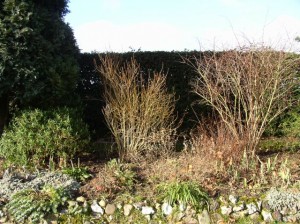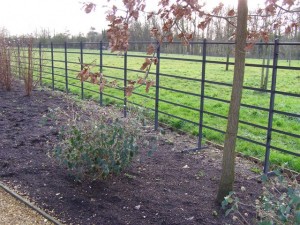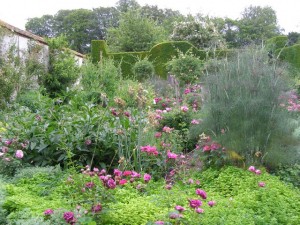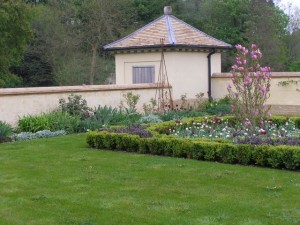
What most garden owners really need is the nerve to grapple with an unruly flower-bed and decide what to keep or throw out - how to deal with thug tendencies, what to plant in a bare patch and how to extend the flowering season. Tired old borders turn up with regular monotony. Perfect time now as part of the autumn gallop to overhaul the garden and make plant changes before the bad weather clamps down on us. Distilled into the 10 Steps below.
1 THE CONSTRAINTS - no avoiding these. There are circumstances that will determine what plants you can actually use. Soil and drainage will be critical, standing in water in a wet winter or baking cracked dry in a hot summer. Then there is microclimate - teeth of the wind or sheltered. Not to mention dry shade under a wall or tree and which way the land faces in regard to hours of sunlight. Where are the services to and from the house buried? You will need to know this when digging a new bed.
2. THE RANGE OF POSSIBILITIES - working these out is like carrying out a mini-survey on the the planting area. Views in and out go first. What is the relationship with the house - can you look at the flowerbed from out of the windows? do you eye it up on approaching the front door? or when parking the car? Do you see this area in the distance or close up under scrutiny? This is going to influence plant choice. It might be that no-one much visits this area in the winter. No need therefore to obsess about evergreens. It might beg for a bench right in the middle - that will call for scented plants.

3 GETTING PRACTICAL WITH THE EXISTING VEGETATION. Don’t know where to begin? Dare you remove the Mother in Law’s rose? The moment of ruthless execution has arrived. Starting from scratch with a flowerbed is infinitely easier than working around the hotchpotch plant beasts that have taken over your mixed border. So how to deal with the random plants? Get a brisk friend round and and draw up a full list. “the one from Aunt Jenny” etc where botanical latin escapes you. Marks out of 10 and the strict rule is that anything with 6 or less goes. Life is just too short. Of those that remain, you might find quite a few are going to get trampled while you grapple with Aunt Jenny’s yellow thing.
4. NURSERY OR HOLDING BED - make one of these and into this can go all those plants. A perfect time to divide up congested clumps of perennials. You may be rich with extra plantlets for somewhere else in the garden.

5. WEED PATROL. Before replanting be ruthless - get the terrible persistent invaders like thistles, convolvulus and ground elder. They are not beautiful, they are efficient and they will strangle off all your lovingly chosen new plants. Sooner or later. Dig well through the bed now and it is a reason for taking a clump of infested perennials out. We advise that you do this now and then be ready to spot dig next spring. Just do not let these monsters have the opportunity to photosynthesise.
6. TAPE MEASURE AND PHOTO TIME - It is an important discipline to measure the size of the border accurately. Also snap and snap away with the camera. Take those measurements inside and get them down on paper. By this means, you will be able to work out scale accurately and now the square meterage of the bed. Vital for accurate quantities when you are ordering plants. Also if you tape a piece of tracing paper down you can doodle and work on the planting design inside. Inspired, by your digital photographs.
7. DESIGN FLIGHTS can now take off. Decide what mood you want from your revamped planting. Jungle? Cottage garden? The seafront at Eastbourne? A woodland grotto? The site will perhaps dictate this to you. Anything to do with the landscape will take its echo from the surroundings - the Genius Loci, if you will. What job do you want the plants to do? What colours? Sizes? Forms? and shapes? What habit (ie how the plant holds itself) will the existing vegetation have and how will it influence newcomers?
8. PLANT CHOICES- after you have looked in all the books and made a decision, make a plant list. Against each plant check this with size and spread. Run through the year in your mind, so that no season that you want to see, gets overlooked. And when you get here, remember that less is more. Think of your colour scheme in the house. Redecoration is done with the aid of a load of swatches but then choice prunes back dramatically. Repetition and rhythm are the mantra. Avoid itsy bitsy clumps - think of covering at least half a m2 with plant clumps.
9. HORTICULTURAL RECIPES for soil improvement should be concocted. Use organic matter to improve the structure and microbial activity in your soil. Spent leafmould or mushroom compost are the best. Do not hold back on any of this, your plants will be only as good as the medium they are growing in. After setting out and planting, mulch heavily. It will do wonders to condition the soil, prevent excessive moisture loss next summer and suppress some weed growth.

10 ADD BULBS - they extend the season of late plants and if sited carefully where the garden spade doesn’t slice into them, are relatively trouble free. A big impact can be made for not too much money. Add them to the plant list and plant after all the shrubs and perennials have gone in.
 What most garden owners really need is the nerve to grapple with an unruly flower-bed and decide what to keep or throw out - how to deal with thug tendencies, what to plant in a bare patch and how to extend the flowering season. Tired old borders turn up with regular monotony. Perfect time now as part of the autumn gallop to overhaul the garden and make plant changes before the bad weather clamps down on us. Distilled into the 10 Steps below.
1 THE CONSTRAINTS - no avoiding these. There are circumstances that will determine what plants you can actually use. Soil and drainage will be critical, standing in water in a wet winter or baking cracked dry in a hot summer. Then there is microclimate - teeth of the wind or sheltered. Not to mention dry shade under a wall or tree and which way the land faces in regard to hours of sunlight. Where are the services to and from the house buried? You will need to know this when digging a new bed.
2. THE RANGE OF POSSIBILITIES - working these out is like carrying out a mini-survey on the the planting area. Views in and out go first. What is the relationship with the house - can you look at the flowerbed from out of the windows? do you eye it up on approaching the front door? or when parking the car? Do you see this area in the distance or close up under scrutiny? This is going to influence plant choice. It might be that no-one much visits this area in the winter. No need therefore to obsess about evergreens. It might beg for a bench right in the middle - that will call for scented plants.
What most garden owners really need is the nerve to grapple with an unruly flower-bed and decide what to keep or throw out - how to deal with thug tendencies, what to plant in a bare patch and how to extend the flowering season. Tired old borders turn up with regular monotony. Perfect time now as part of the autumn gallop to overhaul the garden and make plant changes before the bad weather clamps down on us. Distilled into the 10 Steps below.
1 THE CONSTRAINTS - no avoiding these. There are circumstances that will determine what plants you can actually use. Soil and drainage will be critical, standing in water in a wet winter or baking cracked dry in a hot summer. Then there is microclimate - teeth of the wind or sheltered. Not to mention dry shade under a wall or tree and which way the land faces in regard to hours of sunlight. Where are the services to and from the house buried? You will need to know this when digging a new bed.
2. THE RANGE OF POSSIBILITIES - working these out is like carrying out a mini-survey on the the planting area. Views in and out go first. What is the relationship with the house - can you look at the flowerbed from out of the windows? do you eye it up on approaching the front door? or when parking the car? Do you see this area in the distance or close up under scrutiny? This is going to influence plant choice. It might be that no-one much visits this area in the winter. No need therefore to obsess about evergreens. It might beg for a bench right in the middle - that will call for scented plants.
 3 GETTING PRACTICAL WITH THE EXISTING VEGETATION. Don’t know where to begin? Dare you remove the Mother in Law’s rose? The moment of ruthless execution has arrived. Starting from scratch with a flowerbed is infinitely easier than working around the hotchpotch plant beasts that have taken over your mixed border. So how to deal with the random plants? Get a brisk friend round and and draw up a full list. “the one from Aunt Jenny” etc where botanical latin escapes you. Marks out of 10 and the strict rule is that anything with 6 or less goes. Life is just too short. Of those that remain, you might find quite a few are going to get trampled while you grapple with Aunt Jenny’s yellow thing.
4. NURSERY OR HOLDING BED - make one of these and into this can go all those plants. A perfect time to divide up congested clumps of perennials. You may be rich with extra plantlets for somewhere else in the garden.
3 GETTING PRACTICAL WITH THE EXISTING VEGETATION. Don’t know where to begin? Dare you remove the Mother in Law’s rose? The moment of ruthless execution has arrived. Starting from scratch with a flowerbed is infinitely easier than working around the hotchpotch plant beasts that have taken over your mixed border. So how to deal with the random plants? Get a brisk friend round and and draw up a full list. “the one from Aunt Jenny” etc where botanical latin escapes you. Marks out of 10 and the strict rule is that anything with 6 or less goes. Life is just too short. Of those that remain, you might find quite a few are going to get trampled while you grapple with Aunt Jenny’s yellow thing.
4. NURSERY OR HOLDING BED - make one of these and into this can go all those plants. A perfect time to divide up congested clumps of perennials. You may be rich with extra plantlets for somewhere else in the garden.
 5. WEED PATROL. Before replanting be ruthless - get the terrible persistent invaders like thistles, convolvulus and ground elder. They are not beautiful, they are efficient and they will strangle off all your lovingly chosen new plants. Sooner or later. Dig well through the bed now and it is a reason for taking a clump of infested perennials out. We advise that you do this now and then be ready to spot dig next spring. Just do not let these monsters have the opportunity to photosynthesise.
6. TAPE MEASURE AND PHOTO TIME - It is an important discipline to measure the size of the border accurately. Also snap and snap away with the camera. Take those measurements inside and get them down on paper. By this means, you will be able to work out scale accurately and now the square meterage of the bed. Vital for accurate quantities when you are ordering plants. Also if you tape a piece of tracing paper down you can doodle and work on the planting design inside. Inspired, by your digital photographs.
7. DESIGN FLIGHTS can now take off. Decide what mood you want from your revamped planting. Jungle? Cottage garden? The seafront at Eastbourne? A woodland grotto? The site will perhaps dictate this to you. Anything to do with the landscape will take its echo from the surroundings - the Genius Loci, if you will. What job do you want the plants to do? What colours? Sizes? Forms? and shapes? What habit (ie how the plant holds itself) will the existing vegetation have and how will it influence newcomers?
8. PLANT CHOICES- after you have looked in all the books and made a decision, make a plant list. Against each plant check this with size and spread. Run through the year in your mind, so that no season that you want to see, gets overlooked. And when you get here, remember that less is more. Think of your colour scheme in the house. Redecoration is done with the aid of a load of swatches but then choice prunes back dramatically. Repetition and rhythm are the mantra. Avoid itsy bitsy clumps - think of covering at least half a m2 with plant clumps.
9. HORTICULTURAL RECIPES for soil improvement should be concocted. Use organic matter to improve the structure and microbial activity in your soil. Spent leafmould or mushroom compost are the best. Do not hold back on any of this, your plants will be only as good as the medium they are growing in. After setting out and planting, mulch heavily. It will do wonders to condition the soil, prevent excessive moisture loss next summer and suppress some weed growth.
5. WEED PATROL. Before replanting be ruthless - get the terrible persistent invaders like thistles, convolvulus and ground elder. They are not beautiful, they are efficient and they will strangle off all your lovingly chosen new plants. Sooner or later. Dig well through the bed now and it is a reason for taking a clump of infested perennials out. We advise that you do this now and then be ready to spot dig next spring. Just do not let these monsters have the opportunity to photosynthesise.
6. TAPE MEASURE AND PHOTO TIME - It is an important discipline to measure the size of the border accurately. Also snap and snap away with the camera. Take those measurements inside and get them down on paper. By this means, you will be able to work out scale accurately and now the square meterage of the bed. Vital for accurate quantities when you are ordering plants. Also if you tape a piece of tracing paper down you can doodle and work on the planting design inside. Inspired, by your digital photographs.
7. DESIGN FLIGHTS can now take off. Decide what mood you want from your revamped planting. Jungle? Cottage garden? The seafront at Eastbourne? A woodland grotto? The site will perhaps dictate this to you. Anything to do with the landscape will take its echo from the surroundings - the Genius Loci, if you will. What job do you want the plants to do? What colours? Sizes? Forms? and shapes? What habit (ie how the plant holds itself) will the existing vegetation have and how will it influence newcomers?
8. PLANT CHOICES- after you have looked in all the books and made a decision, make a plant list. Against each plant check this with size and spread. Run through the year in your mind, so that no season that you want to see, gets overlooked. And when you get here, remember that less is more. Think of your colour scheme in the house. Redecoration is done with the aid of a load of swatches but then choice prunes back dramatically. Repetition and rhythm are the mantra. Avoid itsy bitsy clumps - think of covering at least half a m2 with plant clumps.
9. HORTICULTURAL RECIPES for soil improvement should be concocted. Use organic matter to improve the structure and microbial activity in your soil. Spent leafmould or mushroom compost are the best. Do not hold back on any of this, your plants will be only as good as the medium they are growing in. After setting out and planting, mulch heavily. It will do wonders to condition the soil, prevent excessive moisture loss next summer and suppress some weed growth.
 10 ADD BULBS - they extend the season of late plants and if sited carefully where the garden spade doesn’t slice into them, are relatively trouble free. A big impact can be made for not too much money. Add them to the plant list and plant after all the shrubs and perennials have gone in.
10 ADD BULBS - they extend the season of late plants and if sited carefully where the garden spade doesn’t slice into them, are relatively trouble free. A big impact can be made for not too much money. Add them to the plant list and plant after all the shrubs and perennials have gone in.
